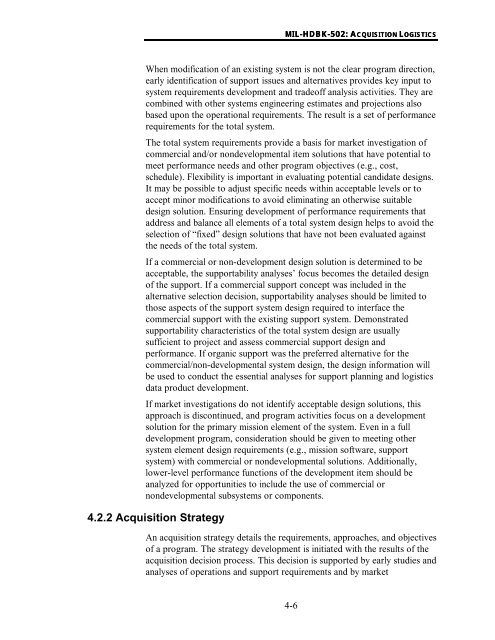MIL-HDBK-502 - Barringer and Associates, Inc.
MIL-HDBK-502 - Barringer and Associates, Inc.
MIL-HDBK-502 - Barringer and Associates, Inc.
You also want an ePaper? Increase the reach of your titles
YUMPU automatically turns print PDFs into web optimized ePapers that Google loves.
<strong>MIL</strong>-<strong>HDBK</strong>-<strong>502</strong>: ACQUISITIONALOGISTICSWhen modification of an existing system is not the clear program direction,early identification of support issues <strong>and</strong> alternatives provides key input tosystem requirements development <strong>and</strong> tradeoff analysis activities. They arecombined with other systems engineering estimates <strong>and</strong> projections alsobased upon the operational requirements. The result is a set of performancerequirements for the total system.The total system requirements provide a basis for market investigation ofcommercial <strong>and</strong>/or nondevelopmental item solutions that have potential tomeet performance needs <strong>and</strong> other program objectives (e.g., cost,schedule). Flexibility is important in evaluating potential c<strong>and</strong>idate designs.It may be possible to adjust specific needs within acceptable levels or toaccept minor modifications to avoid eliminating an otherwise suitabledesign solution. Ensuring development of performance requirements thataddress <strong>and</strong> balance all elements of a total system design helps to avoid theselection of “fixed” design solutions that have not been evaluated againstthe needs of the total system.If a commercial or non-development design solution is determined to beacceptable, the supportability analyses’ focus becomes the detailed designof the support. If a commercial support concept was included in thealternative selection decision, supportability analyses should be limited tothose aspects of the support system design required to interface thecommercial support with the existing support system. Demonstratedsupportability characteristics of the total system design are usuallysufficient to project <strong>and</strong> assess commercial support design <strong>and</strong>performance. If organic support was the preferred alternative for thecommercial/non-developmental system design, the design information willbe used to conduct the essential analyses for support planning <strong>and</strong> logisticsdata product development.If market investigations do not identify acceptable design solutions, thisapproach is discontinued, <strong>and</strong> program activities focus on a developmentsolution for the primary mission element of the system. Even in a fulldevelopment program, consideration should be given to meeting othersystem element design requirements (e.g., mission software, supportsystem) with commercial or nondevelopmental solutions. Additionally,lower-level performance functions of the development item should beanalyzed for opportunities to include the use of commercial ornondevelopmental subsystems or components.4.2.2 Acquisition StrategyAn acquisition strategy details the requirements, approaches, <strong>and</strong> objectivesof a program. The strategy development is initiated with the results of theacquisition decision process. This decision is supported by early studies <strong>and</strong>analyses of operations <strong>and</strong> support requirements <strong>and</strong> by market4-6
















